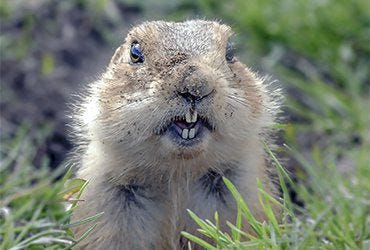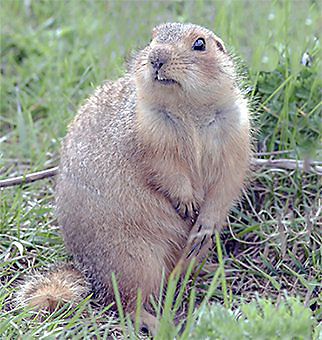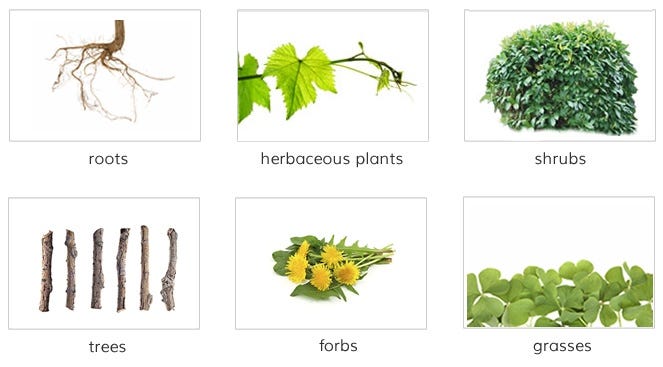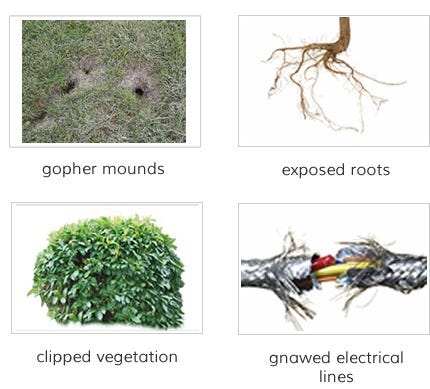





Gophers
Gopher Facts
Pocket gophers are destructive diggers that can be a nightmare for property owners. They use their sharp claws and teeth to excavate underground tunnels and burrows, which can quickly lead to extreme lawn damage. Pocket gophers get their name from the fur-lined cheek pouches that they use to transport food to their burrows. Learn more interesting gopher facts below.

General Gopher Facts
- Number of Pocket Gopher Species: 34
- Average Size: 5-14” long (including a 1-2” tail); about .5 lbs.
- Average Lifespan in the Wild: 1-3 years
- Identifying Features: round, rodent body with soft fur; short neck and a flat head; fur-lined cheek pouches or “pockets” on either side of the mouth; thick whiskers; long, visible incisors; small ears and eyes; strong forequarters with long claws; short tail.

Gopher Geography
All 34 species of pocket gophers are found in the western hemisphere. Of these, 13 reside in the United States. U.S. species are only found in the midwest and western states, with the exception of the southeastern pocket gopher, which can be found in parts of Alabama, Florida and Georgia.
Gopher Habitat

Pocket gophers thrive in a variety of environments and a range of altitudes. Because they are fossorial and live underground, they prefer moist, porous soils with good drainage. Plenty of vegetation is also favored, as gophers eat plants and use them for structure and protection.
Within their home ranges, gophers dig extensive burrow systems. These systems are equipped with travel runs, drainage tunnels and chambers for living, eating and excreting waste.
Gopher Diet
Gophers consume about 60% of their bodyweight in vegetation each day. They are strict herbivores that typically feed on the roots and fleshy parts of plants.
Favorite foods include:

Gopher Behavior
- Activity: Gophers may be active during any season of the year and at any time of day. They live and forage underground and only very rarely emerge from their burrows to gather food.
- Hoarding: Gophers are prolific hoarders. When foraging, they gather food in their cheek pouches to carry down to caching chambers where they save it for later consumption.
- Reproduction: At about one year of age, gophers may begin to breed. Gestation lasts about 3 weeks, after which time female gophers give birth to 2-5 young.
- Social Interaction: Aside from the periods of time when gophers are mating or weaning young, they are solitary animals that live alone. They are also extremely territorial and will fight to the death to protect their tunnel systems and food caches from intruders.
Identify Gopher Damage
Gopher damage is typically a result of their feeding and burrowing habits.

Signs of gopher damage include:
- Gopher mounds: kidney or crescent-shaped piles of soil, marking plugged tunnel entrances
- girdled/clipped trees or shrubs just above ground level
- root damage and/or exposure in trees and seedlings
- loss of surface irrigation due to tunnel drainage
- gnawed electrical lines or water lines for sprinkler and irrigation systems
Damage caused by gophers is often confused with that of moles, but the difference is indicated by their soil mounds and tunnel visibility. While gopher mounds are crescent-shaped, mole hills are more symmetrical and cone-shaped.
Fun Facts
- The lips of a gopher are adapted to close behind his four incisors, preventing dirt from entering his mouth while using his teeth to dig.
- Gophers often move backwards when traveling through their tunnels, using their four-inch tails for navigation.
- Although gophers have poor hearing and eyesight, they have a highly-developed sense of touch, on which they rely heavily for survival. Abundant whiskers and a sensitive tail helps a gopher feel out his surroundings at all times.
- Gophers turn their cheek pockets inside out to clean them.
